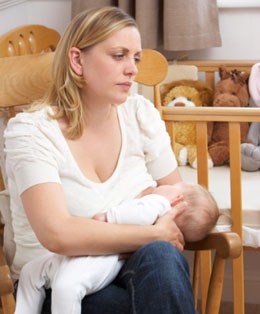
What are the Symptoms of Mastitis
The symptoms of mastitis may differ in intensity, according to the underlying cause. Most severe symptoms are caused by infection, which is characterized by swelling and redness of the breast. Sometimes, pus may come out of the nipple, and the temperature of the affected breast may also increase. Fever, shivers, nausea or vomiting, and muscle pain may also occur. A burning sensation may also develop while breastfeeding the baby. Mastitis due to infection affects one breast only, but in some cases, both the breasts may get affected. In case of engorgement, the breasts do not empty properly after feedings, and this results in accumulation of milk in the milk ducts. This makes the breasts swollen and sore. Usually, the condition affects both the breasts, and can be painful too. Blocked milk ducts affect only a part of the breast, which carries the blocked duct. The affected women may feel dull pain, but extreme cases may cause severe pain and flu-like symptoms. However, mastitis due to infection is the most severe among all.
How is Mastitis Treated
Mastitis treatment is decided according to the underlying cause and the intensity of the condition. According to health experts, breastfeeding has to be continued, even if there is an infection. Any bacteria in the breast milk will be destroyed by the baby’s digestive system. It is very important to seek medical attention at the earliest, to determine the exact cause of the condition, and to avoid complications. In case of non-infectious mastitis, the doctor may prescribe pain killers. The main requirement is draining the accumulated breast milk, which may otherwise lead to infection. Feed the baby frequently from the engorged breast and massage the affected area.
In case of blocked milk ducts, the affected part of the breast can become swollen and red, with a firm mass inside. This is a temporary condition, which may subside within a few days. However, it can lead to mastitis in some cases, as it develops infection. In order to avoid infection, feed the baby frequently, massage the area well, and apply warmth. Both the above said conditions – engorgement of the breast and blocked milk ducts, may lead to infection. Otherwise too, mastitis can be directly caused by infection of breasts.
In case of infection, oral antibiotics are administered for a stipulated period, along with painkillers. This antibiotic treatment is usually prescribed for simple mastitis. In case of acute mastitis, treatment is aimed at healing the abscess developed in the affected breast due to infection. It includes draining the abscess, which may take around one week to heal, oral antibiotics to eliminate the infection, and emptying the breast by feeding or pumping. If there is an abscess, the doctor may advise you to refrain from feeding the baby from the affected breast. Severe cases of breast infection and abscess may require surgery too.
As soon as you notice the symptoms, seek medical attention. You may also prevent this condition by frequently feeding your baby, ensuring that the breast is drained after each feeding, drinking lots of fluids, boosting your immune system with a balanced diet, and by practicing good personal hygiene.

